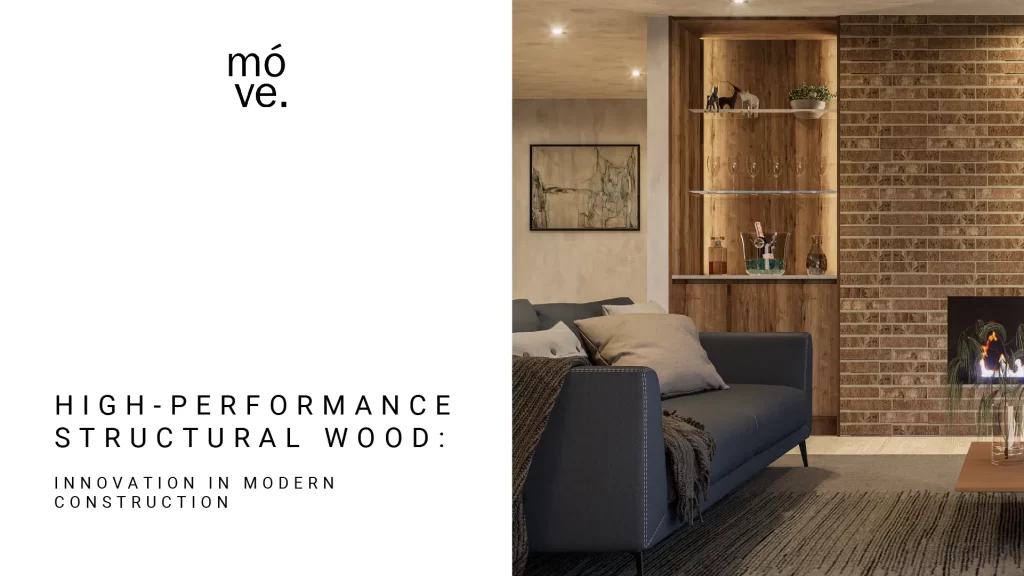HIGH-PERFORMANCE STRUCTURAL WOOD: INNOVATION IN MODERN CONSTRUCTION

For centuries, concrete and steel have dominated the construction landscape. However, a quiet contender is emerging from the forests to claim its place: wood.
This is not the rustic timber of the past. It is a reinvented material, strong, sustainable, and aesthetically striking, capturing the attention of architects, engineers, and builders around the world. Want to know how this ancient material is leading a construction revolution?
Keep reading and dive into the fascinating rise of wood as the structural material of the future.
BEYOND THE CABIN, WOOD MEETS ENGINEERING WITH CLT
If you’ve ever thought of wood as a material limited to small structures or decorative finishes, get ready to be surprised. The heart of this revolution lies in technological innovation, especially with the arrival of cross-laminated timber (CLT).
But what exactly is CLT and why is it making such waves?
Imagine layers of solid wood boards, carefully selected and bonded with high-strength adhesives, with each layer’s grain running perpendicular to the one below. This creates panels with exceptional strength and stability, capable of bearing significant structural loads, even comparable to concrete and steel.
CLT offers many powerful advantages:
Strength and durability
Contrary to common belief, modern wood, particularly CLT, offers excellent structural strength and long-lasting durability, even in harsh weather conditions.
Sustainability at its finest
Wood is a renewable resource. Responsibly managed forests act as carbon sinks, absorbing CO? from the atmosphere. Using wood in construction reduces the carbon footprint of energy-intensive materials like concrete and steel, while also storing that carbon within the building itself.
Speed and efficiency
CLT components are precision-manufactured in factories and arrive ready for assembly. This leads to faster construction times, lower labor costs, and less disruption on-site.
Versatile and aesthetic design
Wood provides unmatched warmth and natural beauty. CLT allows for bright, inviting interiors with exposed wood texture and color, and supports bold and innovative architectural concepts.
Thermal and acoustic insulation
Wood is a natural insulator. This means more energy-efficient buildings with lower heating and cooling needs, as well as improved acoustic comfort.
Lightweight construction
Compared to concrete, wood is significantly lighter. This can reduce foundation costs and make it feasible to build on less stable ground.
Fire resistance
Surprisingly, solid wood elements such as CLT burn slowly and predictably. The outer layer chars and forms a protective barrier, which insulates the interior and helps maintain structural integrity long enough to allow safe evacuation in the event of fire.
BEYOND CLT, A UNIVERSE OF WOOD INNOVATION
CLT is just the beginning. Research and development are fueling other exciting breakthroughs in wood construction:
- Laminated veneer lumber (LVL): Similar to CLT, but with veneers mostly aligned in the same direction. This gives it outstanding bending strength, ideal for long-span beams and columns.
- Laminated strand lumber (LSL): Made from oriented wood strands, offering great versatility for structural and non-structural uses.
- Prefabricated wood construction systems: Factory-built wood modules and panels that speed up construction, reduce waste, and enhance quality.
- Advanced connectors and joints: New systems that allow safe, complex, and flexible wood structures.
- Innovative treatments and finishes: Technologies that improve resistance to moisture, insects, and fire, while offering a wide range of aesthetic options.
WOOD: A BRIDGE TO A MINDFUL FUTURE
The wood revolution is not a trend or passing fashion. It is a smart and necessary response to the challenges of the 21st century, such as the need to build more sustainably, efficiently, and in harmony with the environment.
By choosing wood as a structural material, we invest in:
- A healthier planet, by reducing emissions and promoting sustainable forestry.
- More prosperous communities, by creating opportunities in forestry, manufacturing, and construction.
- More livable spaces, by designing buildings that are functional, beautiful, and focused on human well-being.
So next time you see a wooden building, take a second look. This material represents a quiet but powerful revolution that is transforming the way we build, combining engineering strength with the natural beauty of wood.
The future of construction is deeply rooted in wood.
